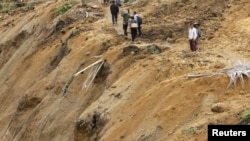JAKARTA —
Perched atop the notorious ‘Ring of Fire,’ an arc of fault lines and volcanoes in the Pacific Basin, earthquakes are an almost weekly occurrence in Indonesia. After close analysis of a mammoth earthquake that struck the island of Sumatra this April, scientists in the U.S. say the quake indicates the Indo-Australian tectonic plate is now splitting in two.
The 8.7-magnitude quake that struck the Indonesian island of Sumatra this April sent shockwaves, literally, around the globe.
After extensively studying the quake and its aftermath, scientists say the rupture is unprecedented.
It was the biggest ‘slip-strike,’ or horizontal rather than vertical quake, ever recorded.
Seismologists say the April 11 quake caused four fault lines to rupture almost simultaneously.
Jamie McCaughey is a geologist from the Earth Observatory in Singapore, an institute that studies earthquakes, volcanoes and tsunamis.
He says the recent study in the scientific journal Nature confirms that the Indian-Australian tectonic plate is splitting in two.
“The evidence is very clear that, and what the authors describe is that, the earthquake is really just illustrating a long-term process and teaching us more about it, that the sea floor of the Indian Australian plate is slowly becoming two separate plates and this earthquake illustrated that process unfolding,” said McCaughey.
It is expected to take millions of years for the plate to divide completely, but the study also shows how earthquakes can trigger other quakes, weeks, and even years after they occur.
The report says there is a high probability the April quake was triggered by the devastating tsunami in December of 2004.
But McCaughey says that rather than seeing a rise in tectonic instability, we are simply witnessing a "dramatic moment in a long-term geological process."
Still, many on the northwest Indonesian island of Sumatra believe it is just a matter of time before another giant earthquake and tsunami strike.
Geologist Surono heads Indonesia’s volcanology agency and says the frequency of volcanic eruptions has increased over recent years.
“The activity of tectonics in Indonesia can influence directly to the volcanoes in Indonesia. After the great earthquake in 2004 in Sumatra, after that all the volcanoes in Indonesia, the character of the volcanoes changed," he stated. "For example, the eruption of [Mt.] Kelud in 2007, it was very different compared with 100 years ago. And then Merapi in 2010, was also a very great eruption. It was very different with previous eruptions.”
Indonesia has the highest number of volcanoes worldwide.
In early September there were also rumblings from Anak Krakatau. The volcano is what remains of a cataclysmic explosion in 1883.
The country’s natural disaster mitigation agency says it is working hard to implement better early warning, monitoring and evacuation systems.
With foreign funding, the government is also mapping earthquake-prone regions across the country.
The 8.7-magnitude quake that struck the Indonesian island of Sumatra this April sent shockwaves, literally, around the globe.
After extensively studying the quake and its aftermath, scientists say the rupture is unprecedented.
It was the biggest ‘slip-strike,’ or horizontal rather than vertical quake, ever recorded.
Seismologists say the April 11 quake caused four fault lines to rupture almost simultaneously.
Jamie McCaughey is a geologist from the Earth Observatory in Singapore, an institute that studies earthquakes, volcanoes and tsunamis.
He says the recent study in the scientific journal Nature confirms that the Indian-Australian tectonic plate is splitting in two.
“The evidence is very clear that, and what the authors describe is that, the earthquake is really just illustrating a long-term process and teaching us more about it, that the sea floor of the Indian Australian plate is slowly becoming two separate plates and this earthquake illustrated that process unfolding,” said McCaughey.
It is expected to take millions of years for the plate to divide completely, but the study also shows how earthquakes can trigger other quakes, weeks, and even years after they occur.
The report says there is a high probability the April quake was triggered by the devastating tsunami in December of 2004.
But McCaughey says that rather than seeing a rise in tectonic instability, we are simply witnessing a "dramatic moment in a long-term geological process."
Still, many on the northwest Indonesian island of Sumatra believe it is just a matter of time before another giant earthquake and tsunami strike.
Geologist Surono heads Indonesia’s volcanology agency and says the frequency of volcanic eruptions has increased over recent years.
“The activity of tectonics in Indonesia can influence directly to the volcanoes in Indonesia. After the great earthquake in 2004 in Sumatra, after that all the volcanoes in Indonesia, the character of the volcanoes changed," he stated. "For example, the eruption of [Mt.] Kelud in 2007, it was very different compared with 100 years ago. And then Merapi in 2010, was also a very great eruption. It was very different with previous eruptions.”
Indonesia has the highest number of volcanoes worldwide.
In early September there were also rumblings from Anak Krakatau. The volcano is what remains of a cataclysmic explosion in 1883.
The country’s natural disaster mitigation agency says it is working hard to implement better early warning, monitoring and evacuation systems.
With foreign funding, the government is also mapping earthquake-prone regions across the country.









